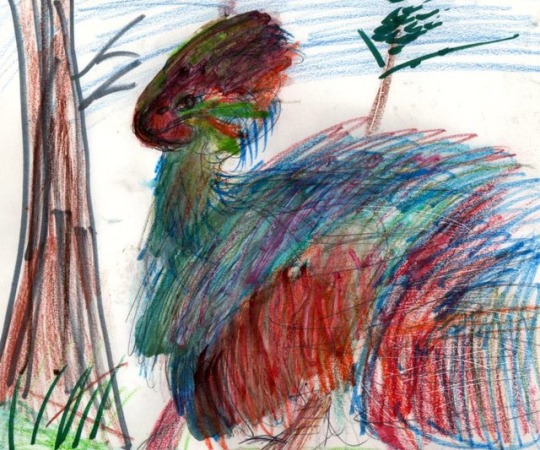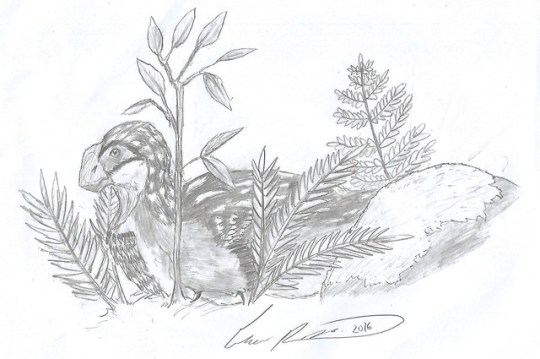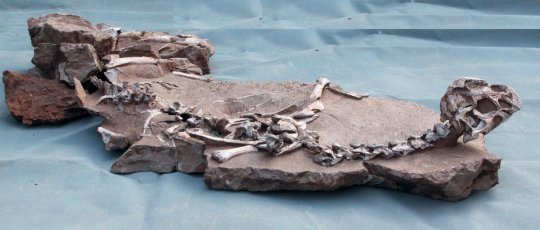#tongtianlong
Text
A group of visionaries have figured out how to bring nonavian dinosaurs to the present, and have determined the 10 species that make the best pets and domesticated them, with an oversimplified guide to what modern pet/livestock/husbandry animals they resemble most. you have done the work, you're completely prepared, and today, you're bringing your new friend home.
you will be able to take care of the pet and they will become your best friend for the rest of your lives. there are no downsides to any of these pets apart from what is in the brief description.
the pets, with image descriptions indicating which is which and artist credit, with artist links attached:










#palaeoblr#dinosaurs#pets#polls#prehistoric life#velociraptor#mononykus#tongtianlong#thecodontosaurus#kulindadromeus#caihong#scutellosaurus#yi qi#yi#psittacosaurus#heterodontosaurus
2K notes
·
View notes
Photo

My colorful feathery floofy interpretation of tongtianlong, an ovaraptorid. They were feathery, omnivorous, and ate eggs and smaller animals. They were medium-smallish.
1 note
·
View note
Photo







Though pachycephalosaurs are probably my favorite dinosaurs, I’ve drawn oviraptorosaurs a lot too. Top piece is Caenagnathasia, 3rd and 5th pieces are Anzu, and the last is Gigantoraptor. I drew the Gigantoraptor in my senior year of high school with no references, so I’m sure parts of it are off, but I still like it.
#oviraptorosaur#oviraptor#gigantoraptor#caenagnathasia#anzu#tongtianlong#huanansaurus#nankangia#ganzhousaurus#jiangxisaurus#banji#incisivosaurus#protarchaeopteryx#ningyuansaurus#caudipteryx#similicaudipteryx#paleo#paleoart#paleoblr#palaeoblr#dinosaurs#dinosaur#maniraptora#theropod#art#traditional#pencil#pen
44 notes
·
View notes
Photo

Day 18 filthy
Two filthy dinosaurs (such as Limusaurus and Tongtianlong) are throwing mud at each other.
16 notes
·
View notes
Text
Ancient Cave in China Filled With 45,000-Year-Old Stone Tools and Animal Bones, New Excavation Reveals
www.inhandnetworks.com
Archaeologists have recovered thousands of artifacts from a cave in Xinjiang (an autonomous region of northern China) including stone tools, bronze and iron artifacts and animal fossils. Some date as far back as the Paleolithic Age, making them roughly 45,000 years old, according to the Institute of Archaeology at the Chinese Academy of Social Sciences.
Around 2,000 artifacts were unearthed at the excavation site Tongtiandong Cave (not to be confused with Tongtianlong limosus, the species of bird-like dinosaur that made the news in 2016 when paleontologists discovered the remains of one that appeared to have died from a literal case of being stuck in the mud). This Paleolithic cave is the first ever recorded in Xinjiang province, according to the Chinese Academy of Social Sciences.
Stone tools recovered from Tongtiandong Cave. Chinese Academy of Social Sciences/Chinese Archaeology
Keep up with this story and more by subscribing now
About one-third of the artifacts were stone tools, with another third comprising fossilized animal skeletons. The species the researchers could identify from the fossilized remains included rabbits, sheep, donkeys, rhinoceroses, bears and birds. They showed clear signs of cutting, burning and otherwise having been manipulated for human use, according to the academy.
The excavation was carried out through a collaboration between Peking University’s School of Archaeology and Museology and the Xinjiang Uyghur Autonomous Regional Institute of Cultural Relics and Archaeology. Archaeologists conducted a preliminary excavation in early 2016 before returning for several months in 2017 to make more thorough and detailed recordings. The findings were recently published in the journal Chinese Archaeology and translated into English for the Chinese Academy of Social Sciences.
An ancient millstone. Chinese Academy of Social Sciences/Chinese Archaeology
Previous research conducted in the cave had revealed stone tools and other archaeological artifacts that suggested human activity dating back to around 10,000 years ago, according to China News Service's English language site.
The archaeologists behind the most recent project discovered that the cave provided “continuous stratigraphic cultural-layer sections,” according to the Chinese Academy of Social Sciences. Meaning, it provided a layer-by-layer view of the Early Iron Age, the Bronze Age, the Chalcolithic Age (also known as the Copper Age) and finally the Paleolithic Age. The findings could help map how the region's inhabitants evolved over the course of tens of thousands of years.
goose messaging, remote machine monitoring, remote secure networks, remote secure networking,secure web based scada , remote diagnostics, remote maintenance, plc programming, intelligent traffic enforcement, ct scanners remote monitoring, mri remote monitoring, healthcare, wireless atm, branch networking,retail, digital signage, wastewater treatment, remote monitoring, industrial automation, automation, industrial transport, inhand, inhand network, inhand networks, Industrial IoT, IIoT, Industrial IoT Manufacturer,Industrial IoT Connectivity, Industrial IoT Products, Industrial IoT Solutions, Industrial IoT Products, industrial IoT Gateway, industrial IoT router, M2M IoT gateway, M2M IoT router, industrial router, Industrial IoT Router/Gateway, industrial IoT Gateway, industrial LTE router, Industrial VPN router, Dual SIM M2M router, Entry level Industrial Router, Cost effective, 3G 4G LTE, WiFi, VPN industrial router for commercial and industrial and M2M/IoT applications, Industrial 3G Router, Industrial 3g router, UMTS router, VPN routerIndustrial 3g router, UMTS router, VPN router, DIN-Rail router, cellular router, Industrial IoT Gateway,Industrial IoT Gateway, M2M gateway, VPN gateway, remote PLC programming, Industrial Cellular Modem, Cellular modem, data terminal unit, 3g modem, Industrial 3G Cellular Modem, 3g modem, industrial cellular modem3g modem, industrial cellular modem, industrial wireless modem, data terminal unit, Android Industrial Computer, Android Industrial Computer, Vending PC, Vending Telemetry, Vending Telemeter, Android Industrial Computer,Android Industrial Computer, Vending PC, Vending Telemetry, Vending Telemeter, Touchscreen & Vending PC, Vending Touchscreen, Vending Telemeter, Vending Telemetry, Vending Computer, Industrial LTE Router, industrial IoT Gateway, industrial LTE router, Industrial VPN router, Dual SIM M2M router, Industrial IoT Router/Gateway, industrial IoT Gateway, industrial LTE router, Industrial VPN router,
0 notes
Link
Named Tongtianlong limosus - “muddy dragon on the road to heaven” - the dinosaur’s fossilised remains were discovered on the building site of a high school near Ganxian, in the Jiangxi Province of southern China. The fossils were unearthed by construction workers who were using TNT to blast away rocks - an activity which, while unexpectedly bringing the dinosaur’s remains to light, also appears to have blown away parts of the fossil, including sections of its arms and tail and its right hind leg.
0 notes
Text
Новые виды животных были открыты в 2016 году
Наука не стоит на месте и каждый год ученые открывают все новые виды животных и растений, живущих в настоящее время и вымерших десятки и сотни миллионов лет назад. Какие самые необычные виды животных были открыты в 2016 году?
1. Загадочный туллимонструм
В 1958 году в Иллинойсе была обнаружена окаменелость животного столь необычного, что исследователи назвали его «монстром Тулли» в честь палеонтолога-любителя Френсиса Тулли, нашедшего ее. В последующие десятилетия ученые спорили, являлся ли туллимонструм червем или слизнем. После изучения 1200 останков Tullimonstrum gregarium они выяснили, что он относится к бесчелюстным — это архаичная группа хордовых черепных, которые почти полно��тью вымерли, за исключением 39 видов миног и 76 видов миксин. Туллимонструм обитал на Земле 307 млн лет назад, его длина составляла 0,3 м, а также он обладал большими глазами и острыми зубами, что указывает на то, что он был достаточно грозным хищником.
2. Родственник тираннозавра размером с лошадь
В 2016 году палеонтологи заявили, что близкий родственник тираннозвра (Tyrannosaurus rex) хоть и не был столь же большим, как всеми признанный «царь динозавров», но обладал удивительно развитым мозгом для своего небольшого размера. Исследователи изучили череп динозавра возрастом 90 млн лет, найденный в Узбекистане.
Анализ черепа Timurlengia euotica показал наличие сложного аппарата внутреннего уха, определив, что слух динозавра был очень острым, способным различать низкочастотные звуки травоядных. Исследование предполагает, что тираннозавры стали умнее еще до того, как их размер увеличился — обе эти характеристики помогли им получить преимущество перед другими хищниками.
3. Редкий черный кит
Прошли годы, но ученые, наконец, поняли, что кит, которого изредка видели рыбаки, далеко не юный представитель вида северный плавун (клюворыл Бэрда, Berardius bairdii), но совершенно новый вид. Понять это помог его размер — неуловимый кит обитает в северной части Тихого океана, его длина составляет 7 м, что гораздо меньше, чем у северного плавуна (12 м). Более того, клюворыл Бэрда — серый, а этот кит был черным, за что и получил прозвище «карасу», что по-японски означает «ворон». Генетическое исследование подтвердило, что карасу — ранее неизвестный вид. Однако он связан с китом Бэрда в том смысле, что у них общий предок.
4. Крошечная лягушка
Новый вид лягушки, открытый в этом году, похож на сверчка — земноводное настолько мало, что может легко поместиться на ногте большого пальца. Возможно, поэтому ученые нашли эту лягушку, обитающую на юго-западных равнинах Индии, только сейчас. Ученые назвали ее Microhyla laterite, эта лягушка живет на каменистой местности, которую власти называют «пустошью». Несмотря на свое название, эти пустоши невероятно богаты своим биоразнообразием, отмечают исследователи.
5. Павлиний паук
Эти крошечные пауки — настоящие знаменитости в мире паукообразных. Открытые в 2015 году черно-белый павлиний паук «Скелеторус» и красно-голубой «Сверкающий маффин» влюбили в себя многих, в основном из-за их яркой окраски и сложных брачных танцев. В прошлом году ученые нашли в Австралии еще 7 красочных пауков — таким образом, всего в роду Maratus 48 видов павлиньих пауков. Все открытые виды размером не превышают 5 мм, включая Maratus bubo, названного так, поскольку он напомнил ученым лицо совы (Bubo — латинское название рода филины).
6. Клингонский тритон
Клингонцы из сериала «Звездный путь» отличались нахмуренными бровями, что и побудило ученых дать новому виду тритона с бугристым лбом такое прозвище. Этот тритон (Tylototriton anguliceps) является одним из 163 еще не описанных видов, живущих в Юго-Восточной Азии, в районе, который охватывает Вьетнам, Таиланд, Камбоджу, Лаос и Мьянму. Он был описан в докладе Всемирного фонда дикой природы за 2016 год. Также в докладе встречаются такие виды, как радужная змея (Parafimbrios lao) и другие земноводные, пресмыкающиеся, растения и млекопитающие. Исследователи призвали политиков защитить этих животных, так как многие из открытых видов живут в среде обитания, которой угрожает человеческая деятельность.
7. Динозавр из грязи
Птицеподобного динозавра с перьями, тощими ногами и костяным гребнем ждал печальный конец около 66 миллионов лет назад, когда он застрял в грязи. Ученые отмечают, что положение животного (голова поднята, шея выгнулась, руки раскинуты в стороны) говорит о том, что он пытался освободиться, что навело ученых на мысль о том, что он застрял в грязи. Хотя у новооткрытого вида динозавра (Tongtianlong limosus) были перья, летать он не мог. Однако его анатомия указывает на другие способности — острый клюв служил для поедания моллюсков, растений, орехов и яиц. Размером ящер был с осла и обитал на территории современного Китая.
8. Тарантул Маркеса
В прошлом году исследователи назвали новый вид тарантула в честь колубмийского писателя Габриэля Гарсия Маркеса, а родовое наименование паука было взято от местного племени индейцев канкуамо, культуре которых грозит уничтожение. Kankuamo marquezi использует острые волоски, растущие снизу брюшка, в непосредственном столкновении с врагами, в отличие других пауков, использующих их в качестве «метательного оружия».
9. Новый вид титанозавра
Открытие ранее неизвестного вида титанозавра (эти огромные динозавры с длинной шеей жили во время мелового периода около 95 млн лет назад) помогло ученым в исследовании мозга этих животных. Как правило, в окаменелостях титанозавров отсутствовал череп, однако образец, обнаруженный в Патагонии имел и череп и несколько шейных позвонков. Sarmientosaurus musacchioi обладал необычайно развитыми чувствами для своего маленького мозга, у него также были большие глазницы, что указывает на хорошее зрение. Анатомия внутреннего уха говорит о том, что он мог слышать низкочастотные звуки, издаваемые, вероятно, другими титанозаврами.
10. Древняя рыба
В 2016 году исследователи открыли 2 новых вида доисторических рыб — Rhinconichthys purgatoirensis был открыт в Колорадо, R. uyenoi — в Японии. Их длина составляла 2 м, они обитали на планете 92 млн лет назад и были планктоноядными. Род Rhinconichthys вымер около 66 млн лет назад, когда падение астероида повлекло вымирание динозавров. Третий вид этого рода — R. taylori — был обнаружен в Англии в 2010 году. Два новых вида могут свидетельствовать о том, что рыбы этого рода обитали во всем мире.
0 notes
Photo


New species of 'weird bird'-like dinosaur discovered in China | The Guardian
A farmer and construction workers in China have discovered the remains of a new species of bird-like dinosaur that appears to have died after getting stuck in the mud. The find, experts say, adds weight to the idea that such animals were thriving shortly before the mass extinction 66 million years ago.
Around the size of a sheep, with a beak, wings and a crest on its head, the flightless creature is thought to be a species of oviraptorosaur - a group of bird-like, feathered, toothless and short-skulled non-avian dinosaurs that were roaming the land in the period shortly before an asteroid slammed into Earth off the coast of Mexico, triggering the annihilation of swaths of life.
“If you saw it alive you would just think it was a weird bird,” said Stephen Brusatte, a palaeontologist at the University of Edinburgh who, with colleagues in China, co-authored the research published in the journal Scientific Reports.
But the newly discovered dinosaur appears to have suffered an untimely demise. “It looked like it got trapped in mud, and that’s how it died,” said Brusatte. “The neck is arched, the head is raised up, like it’s sticking its head above something, and both of the arms are outstretched and to the sides of the body, and so it’s like it’s trying to free itself.”
Named Tongtianlong limosus - “muddy dragon on the road to heaven” - the dinosaur’s fossilised remains were discovered on the building site of a high school near Ganxian, in the Jiangxi Province of southern China. The fossils were unearthed by construction workers who were using TNT to blast away rocks - an activity which, while unexpectedly bringing the dinosaur’s remains to light, also appears to have blown away parts of the fossil, including sections of its arms and tail and its right hind leg.
#Tongtianlong limosus#Tongtianlong#Oviraptoridae#Oviraptorosauria#Pennaraptora#Theropoda#Saurischia#Dinosauria#dinosaur#feathered dinosaur#extinct species#China
53 notes
·
View notes
Text
Who is flashiest tailed birb group??? vote now on phones!!!
#palaeoblr#dinosaurs#poll#raptors#birds#I know dromaeosaurs will probably win but I can dream and hope right?#chickenparrots#anzu#velociraptor#stenonychosaurus#anchiornis#archaeopteryx#confuciusornis#yi
99 notes
·
View notes
Photo

In honor of National Bird Day, here’s a Tag Yourself featuring some very good, but very dead, birbs
Tag Yourself I’m Dreamer
Art credit goes to @palaeoplushies, @artisticthingem, Mark Witton, @thewoodparable, @hauntedmech, Medena Darkorus, @apatchsketches, @saint-nevermore, and @ryuukibart
#dinosaurs#birds#tag yourself#palaeoblr#birblr#deinocheirus#Bradycneme#therizinosaurus#tongtianlong#tsaagan#confuciusornis#gastornis#eocypselus#septencoracias
1K notes
·
View notes
Text
Tongtianlong limosus

By Jack Wood on @thewoodparable
PLEASE support us on Patreon! We really do need all of your support to keep this blog running - any amount helps!
Name: Tongtianlong limosus
Name Meaning: Tongtianyan Dragon
First Described: 2016
Described By: Lü et al.
Classification: Dinosauria, Saurischia, Eusaurischia, Theropoda, Neotheropoda, Averostra, Tetanurae, Orionides, Avetheropoda, Coelurosauria, Tyrannoraptora, Maniraptoriformes, Maniraptora, Pennaraptora, Oviraptorosauria, Caenagnathoidea, Oviraptoridae
Tongtianlong is an Oviraptorid (so a Chickenparrot) from the Nanxiong Formation in Jiangxi Province, China, dating back to the Maastrichtian age of the Late Cretaceous, approximately some time between 72 and 66 million years ago. Unlike other Chickenparrots, it had a dome shaped crest and a very rounded beak, giving its head a very pug-like appearance compared to other Chickenparrots. It was very well preserved, but portions were damaged during the excavation; it was also preserved in a unique pose, its head raised and arms splayed. It may have been trapped in mud, and died during its attempt to break free. It lived alongside a great number of Chickenparrots, such as Banji, Ganzhoussaurus, Jiangxisaurus, Nankangia, and Huanansaurus, as well as other dinosaurs such as Microhadrosaurus, Gannansaurus, Qianzhousaurus, and Nanshiungosaurus.
Sources:
https://en.wikipedia.org/wiki/Nanxiong_Formation
Lü, J., R. Chen, S. L. Brusatte, Y. Zhu, C. Shen. 2016. A Late Cretaceous diversification of Asian oviraptorid dinosaurs: evidence from a new species preserved in an unusual posture. Scientific Reports 6: 35780.
Shout out goes to @tuakpidiwalk!
#tongtianlong#tongtianlong limosus#dinosaur#oviraptorosaur#chickenparrot#paleontology#prehistory#prehistoric life#dinosaurs#biology#a dinosaur a day#a-dinosaur-a-day#dinosaur of the day#dinosaur-of-the-day#science#nature#factfile#tuakpidiwalk#Dìneasar#डायनासोर#ديناصور#ডাইনোসর#risaeðla#ڈایناسور#deinosor#恐龍#恐龙#динозавр#dinosaurio#공룡
165 notes
·
View notes